
by Mannahattamamma (UAE) | Dec 30, 2015 | Cultural Differences, Feminism, Gun Violence, Holiday, Living Abroad, Middle East, Older Children, Peace, Religion, Terrorism, UAE, World Motherhood
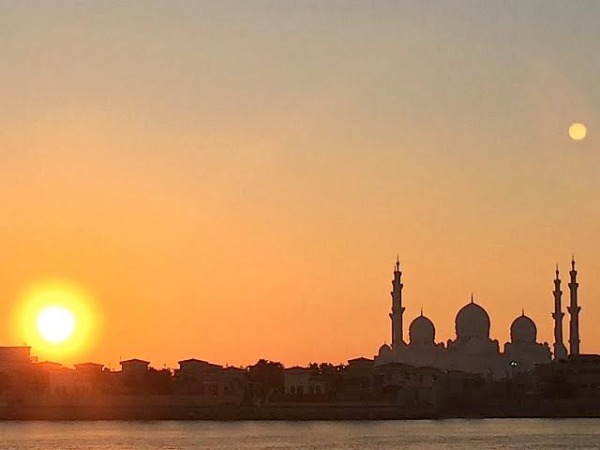
“Will we be safe there?” My 11 year old son asked me that question as we were discussing our winter holiday travel plans, and I suppose, given that we live in the UAE, his question might make sense. In the last few years, we’ve traveled to Jordan, India, Kenya – all places that have been in the news lately as sites of violence.
Where are we going for the winter holidays, you might wonder, that would elicit such a question?
The United States.
I’ll let you think about that for a minute.
Okay, true, his question was a bit of a joke – the question of travel safety has become a running gag in our household, in part because that question is always the first thing my mother (in Illinois) always asks us.
But this time, when he asked the question, none of us laughed. He’d asked us just after the last mass shooting, the one in San Bernandino. And think about that for a minute: I have to specify for you which shooting I’m talking about. Was it the one in Colorado Springs outside Planned Parenthood, or the one in Oregon, or the one…
In other countries, when you say “mass shooting,” there simply aren’t that many to choose from because in the aftermath of the tragedy, governments have changed the laws to make such events less possible. But not in the good ol’ US of A.
When I tell people in the States where I live, there are two questions I am always asked: do I have to “cover” and “do I feel safe?” The answers are “no,” and “yes.” People who didn’t worry about me strolling home after midnight in New York’s East Village in the late 1980s now seem dreadfully concerned about my safety here, in this part of the world, as I drive off to the mall.
Part of why we chose to live abroad with our children had to do with wanting to give them a cosmopolitan perspective on the world: we wanted them to experience other cultures and learn to be open to, rather than threatened by, difference. I know that in the US it is possible to live in cosmopolitan cities—we used to live in Manhattan, where children from many nations crowded into my kids’ classrooms—but it is a different experience to live in a place where “your” culture is not the dominant.
A little while back, for instance, my older son had some friends over so that we could all go to a water park in the afternoon. When I told them it was time to get ready to go, my son said “well, we have to wait a little bit because T. is in the other room doing his prayers.” T. comes from a devout Muslim family and his mother would have been pleased to know that T. didn’t miss a prayer time just because the water park called. And for my son and his other friends, T. doing his prayers was as matter-of-fact as if he’d been changing into his swimsuit, or drinking a glass of water. Ordinary.
Like many of us, at home and abroad, I wrestle with how to explain to my children why the United States can’t simply change its gun laws and why so many people in the country seem afraid of anyone who worships at a mosque rather than a church or a temple. The explanation in both instances seems to boil down to fear: fear of change, fear of difference, fear of that-which-is-not-me.
It’s not much of an explanation, but it’s the only framework I have to explain why Donald Trump, for instance, can still be considered a candidate for the Presidency.
I know that the demagogues like Trump do not speak for all the people in the United States, and that many, many people are outraged by gun violence, but alas, the picture of the country that travels outward to the rest of the world is one of violent, gun-toting Islamophobia – and it’s scary. For me the fear rests not in the thought that Trump will ever be President because I refuse to believe that his bilious self is actually electable. I hang on to that fact as ardently as I once hung on to my belief in Santa Claus. No, my fear rests in the fact that, according to a recent poll, Trump leads the group of Republican Party presidential hopefuls, with 35.8% of the vote.
THIRTY-FIVE POINT EIGHT?
Maybe there really isn’t a Santa Claus.
How do you explain what’s happening in the United States to your children?
This is an original post by World Mom, Deborah Quinn in the United Arab Emirates.
Photo Credit to the author.
After twenty-plus years in Manhattan, Deborah Quinn and her family moved to Abu Dhabi (in the United Arab Emirates), where she spends a great deal of time driving her sons back and forth to soccer practice. She writes about travel, politics, feminism, education, and the absurdities of living in a place where temperatures regularly go above 110F.
Deborah can also be found on her blog, Mannahattamamma.
More Posts
Follow Me:


by Ewa Samples | Dec 4, 2015 | 2015, Communication, Economy, Ewa Samples, Family, Feminism, Happiness, Home, Identity, Inspirational, Life, Life Balance, Motherhood, North America, Parenting, Polish Mom Photographer, Responsibility, USA, Womanhood, Work, Working Mother, World Motherhood

Photo credit: Iryna Ishchenko Photography
Sometime ago, I opened my email and saw this subject line in my inbox: “Mompreneur. Worst word ever.” At first it made me kind of irritated, and I almost moved that email to the trash without reading it. Then I actually read it. I wanted to see who and why would say that a word that describes a business woman who wears way more hats than anybody else, should be so shameful for using that word. At that point in my life I was very proud of using this word to describe myself, and I was curious, because maybe, just maybe, I was missing something. (more…)
Ewa was born, and raised in Poland. She graduated University with a master's degree in Mass-Media Education. This daring mom hitchhiked from Berlin, Germany through Switzerland and France to Barcelona, Spain and back again!
She left Poland to become an Au Pair in California and looked after twins of gay parents for almost 2 years. There, she met her future husband through Couch Surfing, an international non-profit network that connects travelers with locals.
Today she enjoys her life one picture at a time. She runs a photography business in sunny California and document her daughters life one picture at a time.
You can find this artistic mom on her blog, Ewa Samples Photography, on Twitter @EwaSamples or on Facebook!
More Posts - Website
Follow Me:





by Carol (Canada) | Oct 22, 2015 | 2015, Babies, Being Thankful, Canada, Communication, Culture, Family, Feminism, Husband, Kids, Life Balance, Marriage, Me-Time, Mental Health, Motherhood, Parenting, Responsibility, World Motherhood, Younger Children
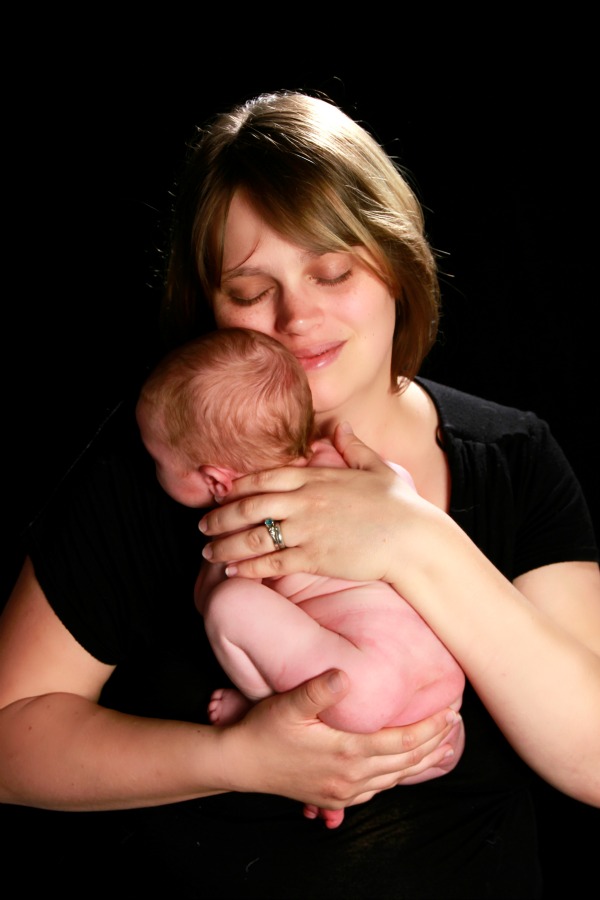
My husband doesn’t like babies. That’s a problem, because in Canada, men are expected to share parenting duties. Women expect help from their husband when a baby is born, and I wasn’t any different. (more…)
Carol from If By Yes has lived in four different Canadian provinces as well as the Caribbean. Now she lives in Vancouver, working a full time job at a vet clinic, training dogs on the side, and raising her son and daughter to be good citizens of the world.
Carol is known for wearing inside-out underwear, microwaving yoghurt, killing house plants, over-thinking the mundane, and pointing out grammatical errors in "Twilight". When not trying to wrestle her son down for a nap, Carol loves to read and write.
Carol can also be found on her blog, If By Yes, and on Twitter @IfByYesTweets
More Posts - Website
Follow Me:


by Mannahattamamma (UAE) | Oct 15, 2015 | Boys, Education, Family, Feminism, UAE, Women's Rights
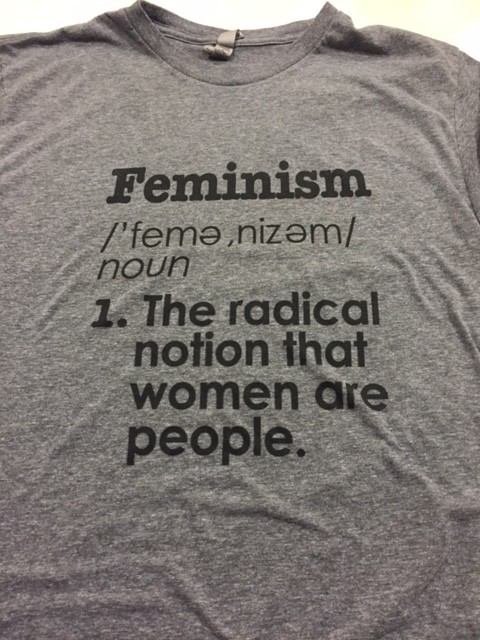
“My grandmother told me that a woman is like the neck and the man is the head,” my student said. “Important but supportive.” The rest of the students in my class on “Global Women Writers” nodded their head in agreement. None of the students is from the same country—in fact, their nationalities pretty much span the globe—but apparently they’d all been given similar sorts of instructions. One girl had been told that she should plan on being an accountant because it would be easy to quit when she got married; another girl said that her mother worried that her brains were going to be threatening to her potential husband.
It’s been interesting to listen to these girls—young women, really—explore history and culture through our readings: we’ve spent time in ancient Japan with Lady Murasaki and Sei Shonagon, visited 17th century Spain with Sor Juana, bounced around the 19th century with Mary Shelley (and her mother Mary Wollstonecraft) and Charlotte Bronte; read Chimimanda Adichie’s TED Talk “We Should All Be Feminists,” and then traced Adichie’s ideas back to Virginia Woolf’s A Room of One’s Own—and back again to Sor Juana.
The list of readings is longer than what I have listed here—we will go to India, New Zealand, Egypt, Nigeria, and the UAE before the term is over—but the students have already noticed a pattern. No matter where we are in time and space, we find variations on the same theme: lack of access. Lack of access to money, education, safety, autonomy—the particulars may change, but always the obstacles seem rooted in the material reality of being female, and how the category of “woman” has been valued (or devalued) through the course of human history.
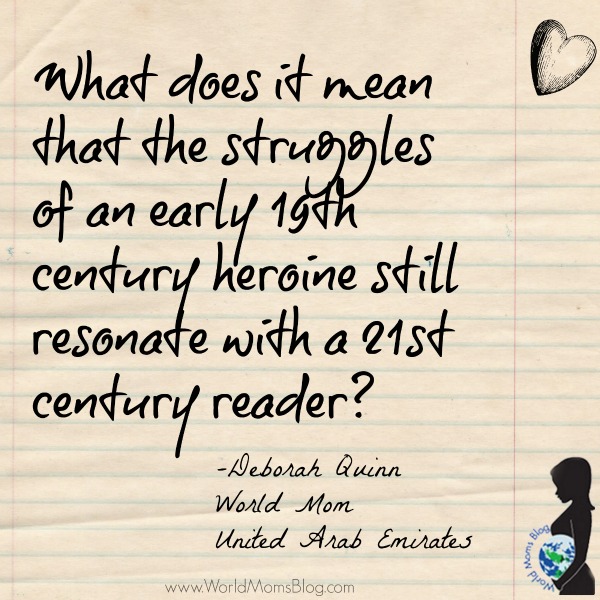
Sor Juana joined a convent so that she could pursue her studies instead of being forced into marriage and motherhood; Jane Eyre famously declared that women “feel just as men feel; they need exercise for their faculties and a field for their efforts as much as their brothers do; they suffer from too rigid a restraint … precisely as men would suffer; and it is narrow-minded in their more privileged fellow-creatures to say that they ought to confine themselves to making puddings and knitting stockings…”
“I love Jane,” exclaimed one student when we read that passage in the novel. “It’s like she’s speaking to me!” When students respond to ideas in the course, I am always delighted, but in this instance, I had to pause.
What does it mean that the struggles of an early 19th century heroine still resonate with a 21st century reader? I know, of course, that men struggle with feeling limited in their choices—as I remind my students, “gender” is something everyone has (although I’ve noticed that when students talk about “gender roles” they mostly talk about women). All the same, however, wouldn’t you have thought that by 2015, we would laugh at the attitudes Jane complains about because they seem so old-fashioned? Instead we experience a flash of recognition that in Jane’s world, as in our own, society insists on placing boundaries around women’s lives.
When I proposed teaching this course, a colleague asked why I had to specify “women.” She wondered why I didn’t just teach a course called “The Global Novel” or something like that. It’s a reasonable question, I suppose, but I think the answer connects, in a way, to why the United Nations decided, two years ago, to declare 11 October the International Day of the Girl: “Empowerment of and investment in girls are key in breaking the cycle of discrimination and violence and in promoting and protecting the full and effective enjoyment of their human rights.” (Click here to see how World Moms Blog celebrated this day.)
Don’t get me wrong – I am the mother of two boys (and no daughters) and while I know that my sons face gender-related struggles, I also know (because I was once a girl, and am now verging on “crone”) that men have not been as systematically pushed to the margins of history. It’s why we have “Secretary Day,” in the U.S., rather than “CEO Day.” We create formal occasions to notice those who would otherwise be silenced, overlooked.
I teach “Global Women’s Writing” because we live in a world where “woman” gets all too easily pushed out of the picture. Ironically, I teach the course in hopes that one day I won’t need to. Perhaps my students–our children–will inherit a world where we don’t need “International Day of the Girl” or a course in “women” writers. Do you think we’ll ever get there?
This post is original to the World Moms’ Blog. Deborah Quinn occasionally blogs at mannahattamamma.com and writes a regular column for The National, the English-language paper of the UAE. Her most recent column can be found here.
Photo credit to the author.
After twenty-plus years in Manhattan, Deborah Quinn and her family moved to Abu Dhabi (in the United Arab Emirates), where she spends a great deal of time driving her sons back and forth to soccer practice. She writes about travel, politics, feminism, education, and the absurdities of living in a place where temperatures regularly go above 110F.
Deborah can also be found on her blog, Mannahattamamma.
More Posts
Follow Me:


by Mannahattamamma (UAE) | Jul 2, 2015 | 2015, Childhood, Feminism, Global Citizenship, Government, Health, Human Rights, International, Motherhood, Newborn Health, Poverty, Save The Children, UAE, USA, World Motherhood

Save The Children
There are some causes that are tricky to rally people around: not everyone wants to ban fur coats, for instance; not everyone thinks that restaurants should post calorie counts on their menus. There are other causes, though, that seem pretty much no-brainers: access to clean water, for instance. Is anyone really going to say “yeah, dirty water, I’m a big fan!” Or saving children. Is anyone really going to say (publicly, anyway) that it’s not a good idea to save children?
Even if we all agree that children should be saved, however, we know that all over the world there are children who need saving, in places where governments and infrastructure don’t seem capable of doing what needs to be done. That’s where organizations like Save the Children step in: they help stitch together the services that can help families survive and give governments a much needed hand.
Save the Children came out with its annual “State of the World’s Mothers” list, which uses five metrics to determine where it’s good to be a mother (and a child). The metrics – maternal health, children’s well-being, educational status (of mothers), economic status, and political status— are combined to give an overall score, which determines where a country falls on the list. Of 179 countries, there are the usual suspects at the bottom of the list—countries where war, natural disasters, and poverty combine in a perfect storm of catastrophe: places like Haiti, or Sudan, or Pakistan.
But there are surprises, too, like the fact that the United States doesn’t even crack the top twenty. Nope, the good ol’ US of A pulls in at 33.
Thirty-third in the world, for a country whose overall wealth and education trumps pretty much everywhere else. The US was beaten by, among others, Slovenia, Belarus, Croatia, and the Czech Republic, as well as all those Scandinavian countries that consistently outperform everyone else when it comes to quality of life issues.
You know what most of these places have that the US does not? A significantly higher percentage of women in government. I suppose a statistician would say that fact is not causal but correlative, and I’m sure that some people would insist that just having women in government won’t automatically make things better for women and children (and thus society), but maybe we should try, and then see what happens?
I live at the moment in Abu Dhabi, in the United Arab Emirates, another wealthy country that doesn’t crack the top twenty on this list. I suppose that for many Westerners, it might seem impossible any Middle Eastern country would score well on a list having to do with women’s lives, but the statistics on this list might help defuse those stereotypes. According to this index, 17.5% of seats in UAE government organizations are held by women, compared to 19.5% in the US; in terms of lifetime risk of maternal death, it is better to be a woman in the UAE: 1 in 5800 versus 1 in 1800 in the US. Women in the US average about 16 years of schooling, women in the UAE about 13; and women in the US tend to be wealthier than women in the UAE (53K for the US, 38K for the UAE).
The Save the Children list doesn’t index maternity leave policy, but that offers another interesting point of comparison.
Women in the UAE only receive 45 days of maternity leave, which isn’t enough, obviously, as any woman who has given birth understands. Women in the US get twelve weeks of maternity leave (although I had to call it “disability” leave in order to ensure that I got the requisite number of days). Twelve weeks, that is, of unpaid leave. John Oliver brilliantly skewered this policy on Mother’s Day, pointing out that the United States aligns with Papua, New Guinea, as the only two countries in the world with no paid parental leave policy. In the UAE, if a woman has a medical certificate that attests to her need for more time at home, she can take up to 100 days of additional (unpaid) leave.
Organizations like Save the Children do invaluable, back-breaking work among desperate populations, but their work raises a question that those of us who live with more privilege should be asking–loudly–of ourselves and our communities: why aren’t we all tied for first place? What has to happen to force “resource-rich” countries take care of its most vulnerable citizens? Why aren’t we doing better?
Where does your country rank in this list? And how do you think your country can do better? Any thoughts?
This is an original post to World Moms Blog by Deborah Quinn in the United Arab Emirates of “Mannahattamamma.”
Photo credit to ‘Save The Children’.
After twenty-plus years in Manhattan, Deborah Quinn and her family moved to Abu Dhabi (in the United Arab Emirates), where she spends a great deal of time driving her sons back and forth to soccer practice. She writes about travel, politics, feminism, education, and the absurdities of living in a place where temperatures regularly go above 110F.
Deborah can also be found on her blog, Mannahattamamma.
More Posts
Follow Me:


by shootiegirl | Jun 9, 2015 | 2015, Feminism, Travel, Turkey
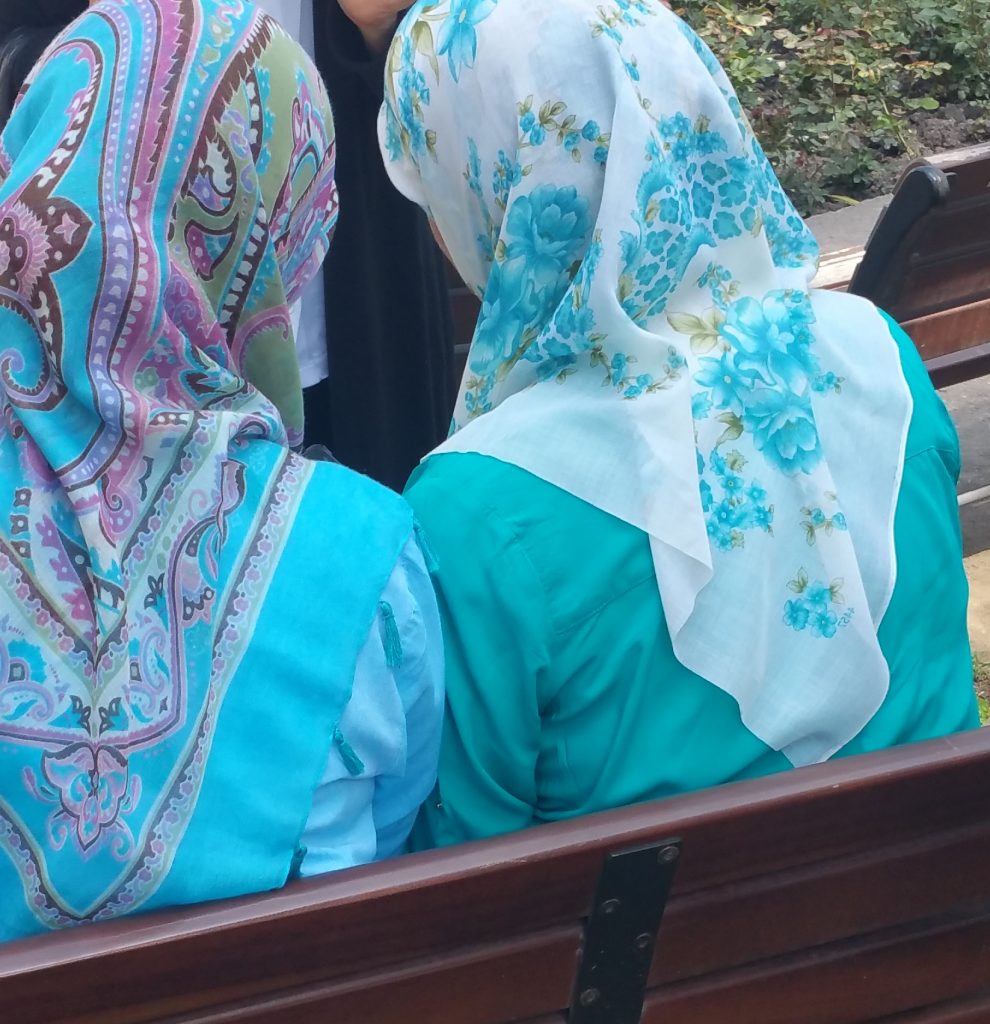 I had the privilege of visiting Turkey recently and found myself marveling at the women. As a predominantly Muslim country, I assumed women wore head scarves, burkas or tesettür (a headscarf and light cover-all topcoat) even in warm climates. However, I was surprised to see women and girls dressed in mostly European styles while shopping, or enjoying an evening out with family and friends.
I had the privilege of visiting Turkey recently and found myself marveling at the women. As a predominantly Muslim country, I assumed women wore head scarves, burkas or tesettür (a headscarf and light cover-all topcoat) even in warm climates. However, I was surprised to see women and girls dressed in mostly European styles while shopping, or enjoying an evening out with family and friends.
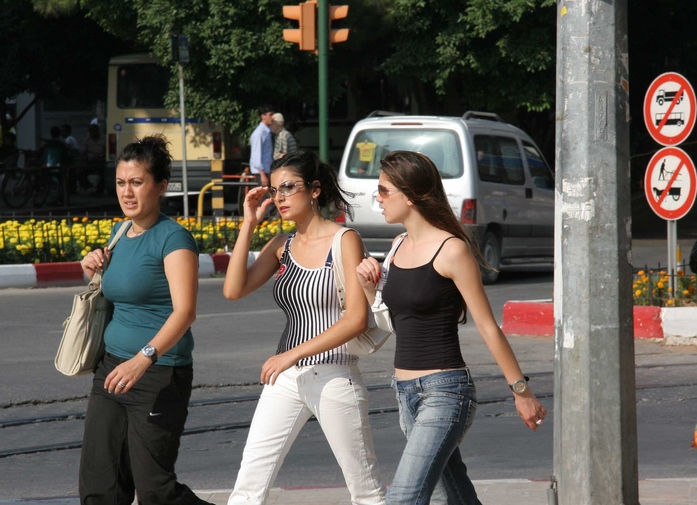
Until late 2013 the head scarf had been outlawed in Turkey in public buildings and universities. More recently the law has been relaxed, and a small percentage of women still wear them. Turkey is considered to be a more western leaninig, secular country. Therefore, in many areas European style prevails over traditional Muslim attire. It was easy to find women dressed in jeans and casual wear as well as skirts and dresses.
The point of departure for me came when entering a mosque for worship or observation. In this case, all women and girls were required to enter with a head scarf. Some mosques had scarves available and required women to use them if they do not bring their own. A fellow travel friend of mine liked her scarf so much that she donated money to the mosque to keep her scarf. If skirts were above the knee, an additional wrap was provided to cover them, creating a longer length.
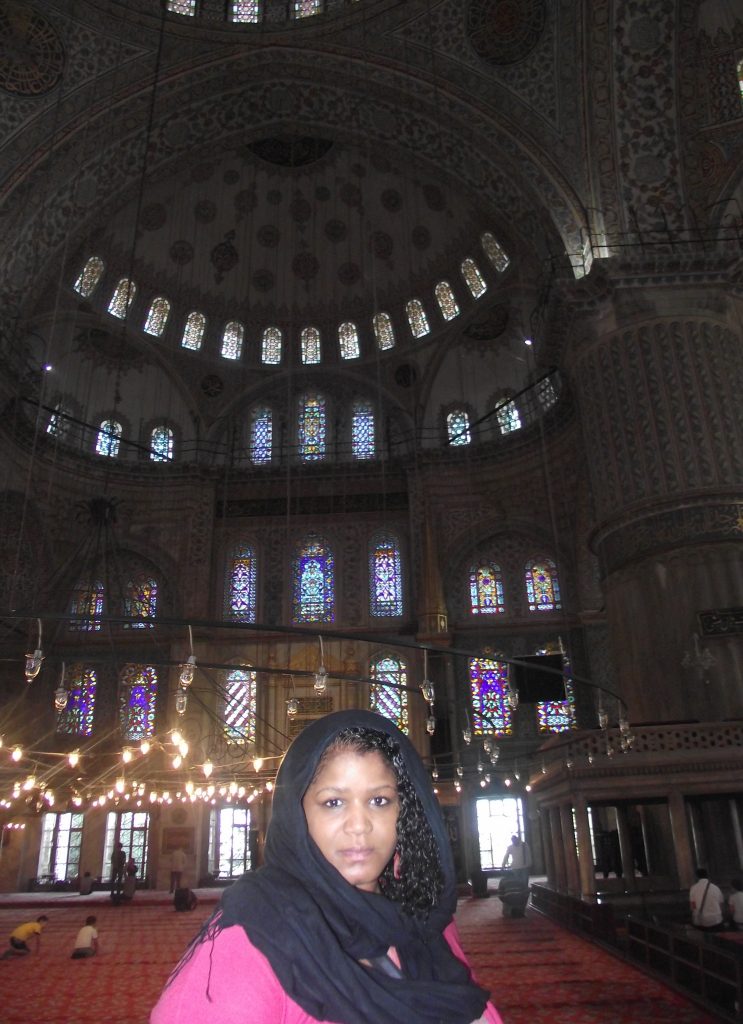
The author at the Blue Mosque in Istanbul, Turkey
In my experience I found that the Turkish people are quite accepting of most styles of dress, no matter your country of origin or cultural background. However, it is customary in the less urban areas for women to be dressed more modestly with sleeved tops, slacks or knee-length dresses or skirts.
What does your attire say about you?
This is an original post written for World Moms Blog by La Shaun Martin of shootiegirl.

LaShaun Martin is National Director of Social Media and Community Service for Mocha Moms, Inc. a national 501(c)(3) support group for stay-at-home mothers of color. LaShaun currently works to manage and promote community service programs for the organization to include teen mentoring, Boys Booked on Barbershops literacy program, America’s Promise, MomsRising, Moms Clean Air Force, U.S. Environmental Protection Agency, and U.S. Department of Education. She is a frequent guest of the White House for events focused on women and girls including tea with First Lady Michelle Obama.
LaShaun holds a Bachelor of Science degree in Business Administration. LaShaun spent 20 years with the State of California, the State of Maryland Department of Corrections managing public education, research, FBI programs and later Hewlett Packard. LaShaun now serves as CEO and Designer of her own company, Shootie Girl™ Custom Rhinestone Apparel and Shootie Girl™ Blog – Positive Messages for Women and Girls. Shootie Girl™ designs have been featured with CNN’s Soledad O’Brien, Sherri Shepherd of The View, Carol’s Daughter, Clinique Cosmetics, Jack and Jill of America, Inc., Still Standing Movie, Dr. Sherry Blake of Essence Magazine and Aja Dantzler of R&B singing couple Kindred and the Family Soul and Blogalicious.
LaShaun is passionate about giving back and ensures her company reflects a heart for service by donating many “t-shirts for a cause” to Heart of Haiti, the women of Zimbabwe and The United Nations Foundation Shot@Life Campaign. She also serves on the Advisory Board of MOMentumNation and the Epilepsy Foundation.
LaShaun’s greatest passions are her husband, two lovely daughters and music.
Blog: http://www.shootiegirl.net
Custom Rhinestone Apparel: http://www.shootiegirl.com
More Posts

















 I had the privilege of visiting Turkey recently and found myself marveling at the women. As a predominantly Muslim country, I assumed women wore head scarves, burkas or tesettür (a headscarf and light cover-all topcoat) even in warm climates. However, I was surprised to see women and girls dressed in mostly European styles while shopping, or enjoying an evening out with family and friends.
I had the privilege of visiting Turkey recently and found myself marveling at the women. As a predominantly Muslim country, I assumed women wore head scarves, burkas or tesettür (a headscarf and light cover-all topcoat) even in warm climates. However, I was surprised to see women and girls dressed in mostly European styles while shopping, or enjoying an evening out with family and friends.




